The Group has helped rebuild, restore or replicate a diverse range of carriages, structures and other fascinating parts of the railway’s heritage over the years. This page does not try to list them all, but it hopefully gives you an insight into a selection.
The Boat
Our first Group Chairman, Michael Seymour, wanted to see a replica of “The Boat”, a whimsical gravity inspection vehicle used by the Spooner family in the 19th Century.
The original came to a bit of a sticky end when its owner disobeyed his own rules and crashed into an up train in 1886!
When Michael died he left money to build a replica, which now appears occasionally at festival weekends, perhaps most notably at the 2010 Quirks and Curiosities event, when it successfully sailed across the Cob in both directions.

The Boat at Harbour Station (Photo: Adrian Gray)
The Waggon Tracks project
Waggon Tracks had twin aims, firstly to create a storage facility for our unique collection of historical waggons, secondly ensure some of the railway’s pre-restoration track continued to have a home and serve a useful purpose well into the 21st Century.
The Waggon Tracks shed is a purpose built, 90 metre-long, five road shed. It contains not just the 60 slate waggons and assorted goods vehicles which have been restored to date, but also those awaiting restoration.
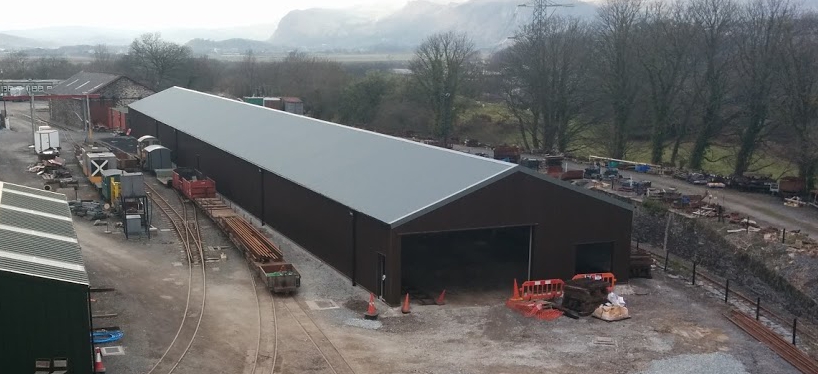
Four of the five sidings in the new shed are laid in bullhead track, with the other road using the older double head. There’s even a short section of stone sleepered ‘t bulb rail’, dating back to the pre-steam era.
More details of the project can be found here.
The ‘Flying Bench’ and Porthole Bugbox
As you can probably imagine, the first passenger vehicles were somewhat basic. Two were completely open to the – often damp – Welsh elements, aside from a leather apron to protect passengers’ legs. Canvas awnings were added in 1871, before they were both rebuilt. This saw them completely enclosed, with full glazing on each side – the complete opposite of their original incarnation.
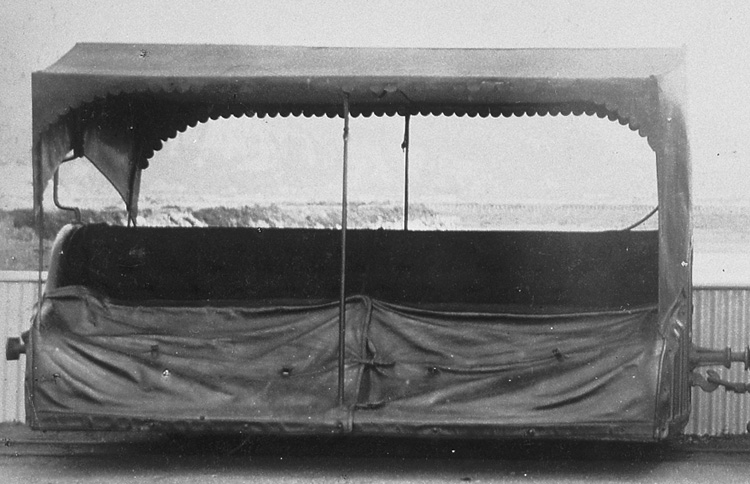
The Flying Bench – in 1887 and today…
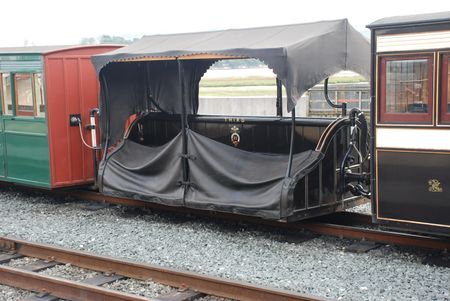
(Photos: Festipedia)
What ventilation there now was came from three ‘porthole’ vents in each end. They survived into the 1950s revival era, but were now in such a poor state, one had to be scrapped, with the other placed in storage.
It was not until the late-60s that an attempt at restoration was made, with a decision taken to return it to its original condition. Whilst clearly unique, Health and Safety regulations, even in the 1970s, meant it was considered unsuitable for ordinary service; however permission from HMRI to run it on special occasions was granted in the 90s, provided a suitably competent person – usually a guard – travelled in the vehicle.
What was missing was the ‘tent’ and awnings, until, sponsored by the Group, these were recreated in time for the Quirks & Curiosities event in 2010. Now, once again passengers can travel in authentic 1870s, Victorian grandeur!
Thanks to Norman Bond and Team X, there’s also now the chance to ride in a replica Porthole Bugbox. This recreates the style these carriages had between the wars, with wire meshes in place of the fully glazed windows. The portholes are obvious in the vehicle ends in the photo on the right.
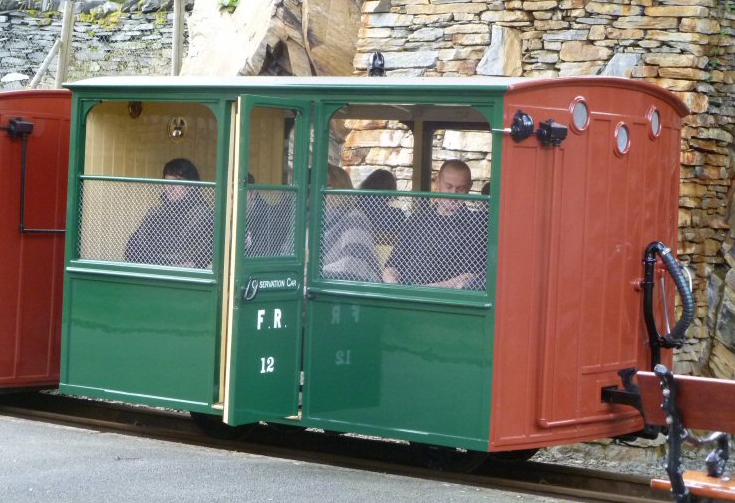
Replica Porthole Bugbox (Photo: Jim Hewett)
Replica loco headlamps
Traditional FR lamps had black bodies and used oil flares, but unfortunately these simply wouldn’t meet modern day safety standards – the FR Rule Book stipulating locomotives should either carry a white bodied lamp, to give contrast against the smokebox, or a light of sufficient brightness to ensure it can been seen by pedestrians on the Cob and track workers.
It resulted in the far from satisfactory sight of vintage locos sporting BR style lamps, something Jim Hewett, a former Group Chairman, felt needed addressing.
After an extensive search for a suitable manufacturer, the Hetherington Lamp Company in Welshpool was contracted to produce replicas, basing their design on a pair of original lamps which had survived from the pre-restoration era. In the meantime, Jim solved the brightness issue by building an LED cluster powered by rechargeable batteries.
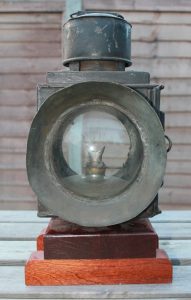
An original headlamp donated by Mike Sharman (Photo: Adrian Gray)
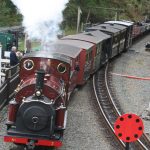
Prince during the 2015 Vintage Weekend (Photo: Chris Humphrys)
Today you can see the results when any of the FR’s genuine or replica vintage fleet are on duty – hopefully suitably lit in accordance with the rule book!
And if you would like to see an original lamp, head to the National Railway Museum in York, where two sit proudly on Livingston Thompson.
Minffordd platform shelter
The shelter you now see on the Porthmadog bound platform took over ten years in planning and fund raising. It replicates as far as possible an earlier shelter, demolished in 1956, although some modifications were made to help it survive the rigours of the Welsh climate. It was finished in spring 2002 and was shortlisted in the National Railway Heritage Awards that year.

Minffordd down platform (Photo: Stewart MacFarlane)
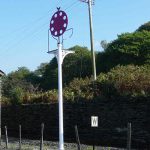
The Boston Lodge signal (Photo: Peter Asquith)
Disc Signal Restoration
Disc signals were used on the Festiniog from the mid-19th century until the 1920s. Although falling out of use, a number survived and have been slowly repaired and reassembled. Those with sharp eyes will be able to spot them outside the old loco shed at Boston Lodge and in the field by the entrance to Minfford yard. However the easiest to spot is on the Cob, now returned to use as a fixed distant signal as you near Porthmadog, where trains will whistle twice to warn the signalman of their approach.
Carriage 21 and other replica vehicles
Carriage 21 was one of a pair of ‘tourist’ coaches built in 1897. Its partner, Carriage 22 is still in regular passenger carrying service, although it bears little resemblance, and contains no original material, following a major rebuild.
No. 21 was scrapped in the 60s, but recently re-born thanks to the volunteers of Team X, carrying its first passengers in September 2019. The green and ivory livery is representative of that used in the early preservation era.
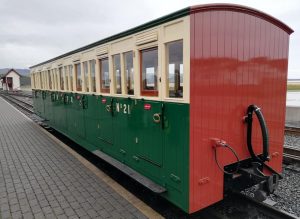
Carriage 21 at Harbour Station, 2019 (Photo: Glenn Williams)
Both 21 and 22 were originally designed to carry 56 passengers – 8 per compartment; the FR’s Dandy Waggons on the other hand were built to take just one, although it would have had four legs!
Prior to the introduction of steam, empty slate wagons would have been hauled up hill by horse power, with each horse working a section of around three miles in length. Another animal would then take over, with the first loaded into a special ‘Dandy Waggon’ and riding back down in style, enjoying a well-earned rest in the process.
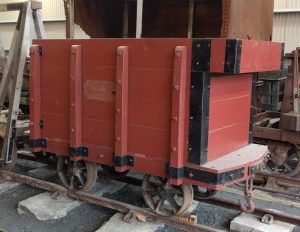
Replica wooden Dandy Waggon (Photo: Waggon Tracks Team)
More information on these unique wagons can be found on Festipedia. It’s thought there were around 40 built over time, but only one original survives (now in the Welsh Highland Heritage Museum at Gelert’s Farm). A wooden replica, shown above, was built in the 1980s and makes an occasional appearance on today’s gravity trains, although the one time we tried to persuade a real horse to get on-board, it refused…
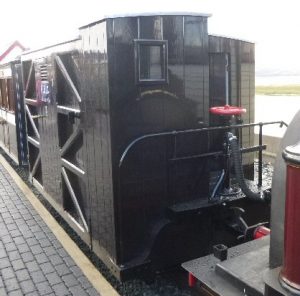
Van 3 at Porthmadog Harbour Station (Photo: Jim Hewett)
Van 3 replicates another unique vehicle – the ‘sentry-box’ brake van. In early-days passenger trains would gravitate downhill, with a guard controlling the train’s speed via a hand brake on the front platform. The small wooden shelter would have offered some protection from the elements, although getting on or off the vehicle would have been tricky at some stations.
Iron bogie waggon
The group was involved in the restoration of waggon No.8, a 6-wheeled ‘Iron bogie’, which is a simplification of the Cleminson design. It required dismantling, cleaning, painting and refurbishment of all moving parts, as well as the replacement of the floor. One potential final job is the provision of a corrugated iron roof, as once carried.
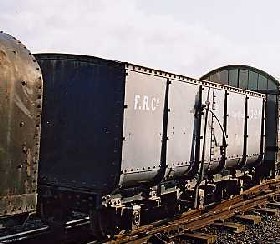
The Iron bogie (Photo: Martin Cowgill)
